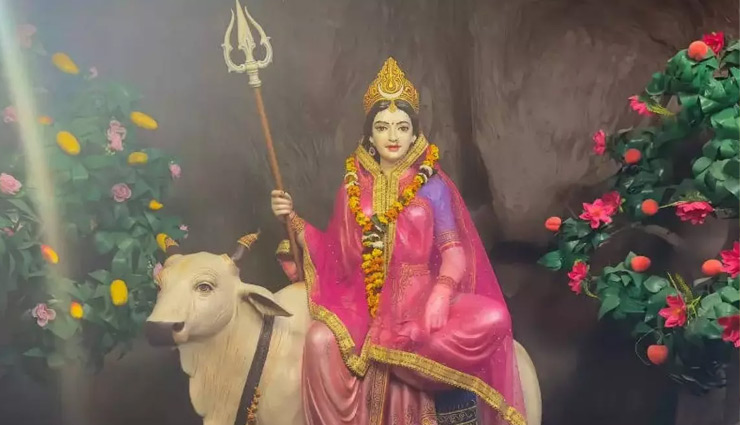Navratri 2024- Here Is Everything You Need To Know About Maa Shailaputri
By: Priyanka Maheshwari Thu, 03 Oct 2024 5:42:18

Maa Shailputri is one of the most revered incarnations of Goddess Durga. She is celebrated as one of the Navadurgas and is worshipped on the first day of the Navratri festival. The name "Shailputri" is derived from two Sanskrit words: "Shail," meaning mountains, and "Putri," meaning daughter, which collectively signifies "daughter of the mountains." Shailputri is also known as Mata Sati Bhavani, Goddess Parvati, and Maa Hemavati, and is referred to as "Pratham Shailputri," as she is the first Devi worshipped during Navratri.
ABOUT THE STORY OF SHAILPUTRI DEVI
Goddess Shailaputri holds a prominent place among the forms of Goddess Durga. She was born as the daughter of the King of Mountains, Parvat Raj Himalaya. The name "Shailaputri" literally means the little girl (Putri) of the mountain (Shaila). She is also known as Sati Bhavani, Parvati, or Hemavati, the daughter of Himavat, the ruler of the Himalayas.
In her previous birth, Maa Shailputri was the daughter of King Daksha, known as Sati. In King Daksha's absence, his wife Prasuti arranged Sati's marriage to Lord Shiva. However, King Daksha disapproved of this union and was deeply offended, severing all ties with his daughter. The thought of Sati marrying Lord Shiva tormented him, and his anger grew. To express his resentment, Daksha organized a grand Yagna, inviting all gods and sages except for Lord Shiva and Sati. Despite this, Sati wished to attend the Yagna, seeing it as an opportunity to reconnect with her parents after a long time spent in the Himalayas with Lord Shiva.
Against Lord Shiva's wishes, Sati insisted on attending. Upon arriving at the Yagna, her joy was short-lived as King Daksha insulted Lord Shiva publicly. Unable to bear the humiliation of her husband, Sati sacrificed herself in the fire of the Yagna. She then took rebirth as the daughter of Himavat, named Himavati (Parvati). In this new life, she eventually married Lord Shiva again.

THE ICONOGRAPHY OF MAA SHAILPUTRI
Maa Shailputri is depicted with a serene expression and a gentle aura, seated on a Nandi. She has a crescent moon on her forehead, holding a trident in her right hand and a lotus flower in her left.
Ruling Planet
Maa Shailputri, also known as Pratham Shailputri or the first Navratri Devi, is worshipped with deep devotion on the first day of Navratri. She is associated with the Moon, and it is believed that worshipping her sincerely can alleviate the adverse effects of this planet.
Chakra Association
Maa Shailputri is linked to the Muladhara (Root) Chakra, which is red in color. From a yogic perspective, the first day of Navratri marks a highly auspicious time, symbolizing the commencement of a devotee's spiritual journey. Many devotees engage in meditation, chant mantras, and perform specific rituals to honor Maa Shailputri, seeking Siddhis and blessings from her.
As the embodiment of Muladhara Shakti, Goddess Shailputri imparts life lessons by awakening an individual's self-consciousness. The Muladhara Chakra serves as the foundation for our bodily awareness. Consequently, many individuals, including sages and gurus, observe fasting on this day and focus their energy on the Muladhara Chakra to connect with the divine power, heighten their self-awareness, and gradually ascend the spiritual path. This experience is a profound journey of soul-searching. Shailputri Mata, as the goddess of the Root Chakra, begins her ascent as Shakti toward Shiva, who resides in the Crown Chakra (Sahasrara).
This journey initiates one’s spiritual awakening and realization of life’s purpose. Without energizing the Muladhara Chakra, individuals lack the strength to confront life's challenges. Therefore, during the first day of the Navratri pooja, yogis concentrate on the Muladhara Chakra, marking the commencement of their spiritual discipline. From a yogic standpoint, the first day of Navratri is regarded as a significant opportunity to align with the Divine Mother Durga and the energy of the Muladhara Chakra for stability and strength.
WORSHIPPING MAA DURGA SHAILPUTRI
The first day of Navratri holds special significance as the worship of Maa Shailputri begins with the ritual of ‘Ghatasthapana.’ She is seen as the embodiment of the Earth and all that exists within it, revered as Mother Nature.
Ghatasthapana Ritual:
- An earthen pot is filled with the first seven types of soil, known as Saptmritika, which are placed inside the pot along with seven varieties of food grains and barley seeds.
- Water is sprinkled on the seeds to keep the soil moist.
- A Kalash is prepared with holy water (Gangajal), some Akshat, and five types of coins, along with Durva leaves. Five mango leaves are placed upside down around the Kalash's brim, topped with a coconut.
- Optionally, cover the coconut with a red cloth or tie moli around it. The Kalash is then placed inside the earthen pot containing the grains.
- Invoke Goddess Durga in her Shailputri form by chanting the Pratham Shailputri Mantra, “Om Devi Shailputryai Swaha,” 108 times, along with the following:
- Vande Vanchhit Laabhaay, Chandrardhkritshekharaam | Vrisharudham Shooldharaam Shailputriim Yashaswinim ||
- Meaning: “I worship Goddess Shailputri to fulfill my wishes, who is adorned with a half-moon on her head, rides on a bull, carries a trident, and is illustrious.”
- Conclude the ritual with the recitation of the Durga Aarti and Shailputri Aarti.
- Perform the Panchopchara Pooja, which includes lighting a ghee lamp, burning dhoop sticks, offering flowers and scent, and presenting Naivedhya made of fruits and sweets to the Kalash.
Benefits of Performing Maa Shailputri Puja:
- Alleviates negative influences of the Moon
- Promotes peace, harmony, and overall happiness
- Shields against diseases and negative energies
- Strengthens the bond of love in marriages
- Provides stability and success in career and business
Related Stories:
# 10 Breathtaking Beautiful Lakes You Must Visit in Ladakh
# 15 Hotels in India for the Perfect Destination Wedding Experience
# 10 Captivating Tourist Spots in Meerut: Where History Meets Modernity





